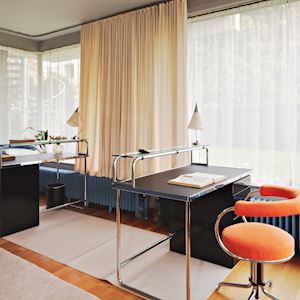
02. Studio
Huis Sonneveld was completed in 1933, and what you see here is a careful reconstruction of what it looked like then, including the soft furnishings, furniture and fixtures. It's one of the best surviving examples of the architectural style known as Nieuwe Bouwen, or Dutch Functionalism. The architect was Leen van der Vlugt, of the firm Brinkman & Van der Vlugt. The partnership had also designed the Van Nelle coffee, tea and tobacco factory, one of whose directors was the owner of this house, Mr Sonneveld. As well as designing the building itself, Van de Vlugt was responsible for the interior and furnishings. He created an ultramodern, luxurious home made precisely to the owners' specifications. Two of the most striking things about the room are the large amount of light and the proximity of the garden: three of the four walls consist of large windows. This studio, as it was known, was intended for the two daughters of the Sonneveld family. The elder one was Magda, nicknamed Puck, who was 19 when the family moved into the house in 1933. Gesine, usually known as Gé for short, was seven years younger. Puck and Gé used the studio for reading, listening to music and receiving their friends. It's the only room in the house with parquet on the floor, probably so that it could be used for dancing when the daughters had parties here. The two desks and the table and chairs are made by Gispen, the Rotterdam company which supplied nearly all the tubular steel furniture in the house. The built-in couch against the wall was designed by the architect himself. It's a multipurpose piece of furniture that also served as a bookshelf, cupboard and sound system. There's a speaker on the right-hand side and a gramophone beneath the lid; the control panel with the volume and tuning buttons is next to the seat. This is one of a number of high-tech gadgets in the house. It's connected to other rooms, each with its own speaker and control so that people could listen to the music chosen in this room.
We suggest that you now go up the main staircase to the living quarters on the first floor.


Sonneveld House is one of the best-preserved houses in the Dutch Functionalist style. The villa was designed in 1933 by architecture firm Brinkman and Van der Vlugt for Albertus Sonneveld, a director of the Van Nelle Factory.
- Museumpark 25
- Rotterdam Netherlands
- 010 440 1200
- nieuweinstituut.nl
